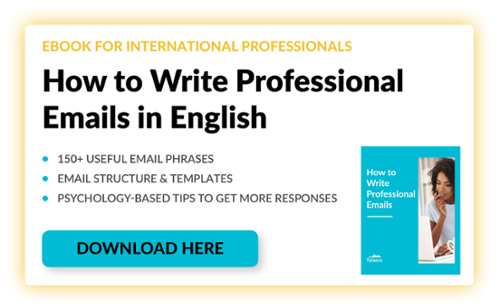By Neya Abdi on Jan 3, 2022 11:00:00 PM
Writing a professional email in English can be difficult, even for native speakers. Why? There are casual ways we use the English language that are big no-nos when crafting this kind of correspondence. But it’s not as difficult as it sounds. We’ve got you covered with 5 quick tips for writing a polished and professional email. You can also make your emails richer and more profesisonal with these +150 useful phrases for business emails or download our free email writing guide.
5 Quick Tips for Writing Professional Emails in English
Let's have a look at those tips that may seem simple, but truly make a difference. Drop your favorite tip in the comments section below.
1. Understand your purpose and state it clearly
A professional email should be concise and to the point. Think about why you’re writing. Is it to request information? Propose a date for a meeting? Once you’ve opened with a polite salutation (more on that later) quickly jump into why you are contacting the person.
- “I am writing in regard to…”
- “I’d like to enquire about…”
People are busy, which means they will probably scroll through your email. Your chances of getting a response are greatly improved if they can quickly understand what you want. If it’s lengthy, they may mark it as something to deal with later, even if it’s a small request. Learn how to Write Clear Emails With These 4 Practical Concise Writing Tips.
2. Open with a polite salutation
If this is a formal email, and you do not know the person well, stick with “Dear [Insert Name]”. If you have been in contact with someone for some time, and you want to be casual but professional a simple “Hello/Hi [Insert name]" is fine.
Mr. is used for males and Ms. is the safest option for females. There is a Mrs./Miss distinction for married versus unmarried women, but unless someone has specifically indicated one of those on a form or application, play it safe with Ms. since this title makes no assumptions.
Choosing to use the last name versus first name is a little more complicated. If you have never met the person, play it safe by using their title and last name. When they respond, pay attention to how they sign the email.
If they write, “Thanks, David” then you’re safe to use their first name. If they just say “Thanks” and only include their automatic signature “David Foster, VP Finance, etc” then you may want to keep it formal until you get some indication that you’re familiar enough to address them by their first name.
When in doubt, keep it formal. If someone really doesn’t like being referred to by their last name, they’ll tell you. (“Please. Call me David.”) Above all, make sure you spell their name right! Spelling someone’s name wrong will spoil your email faster than the wrong salutation ever will.
Learn more email greetings and email openings and choose the right ones for each email.
3. Break up your paragraphs
Your recipient probably reads a lot of text during the work day. Your email should be concise to begin with, but if you absolutely have to write something longer avoid chunky paragraphs.
We don’t read things on screens the same way we read things off paper. You’re more likely to skim through an online article than an article in a newspaper.
A chunky email fatigues the reader, making them more likely to associate it as a chore and put it aside until later. Breaking your email up into manageable chunks makes it easier for your recipient to whiz through.
4. Write a clear email subject line
Your recipient has dozens of emails waiting for them. Like most people, they’ll quickly scan the subject lines and prioritize each item. A vague subject (or in some cases no subject) will shoot straight to the bottom of their mental “to read” list.
It doesn’t have to be creative or funny — it just has to quickly say what the email is about.
It should be short (six words or less), free from unnecessary filler words like “hello”, and it should not be vague.
For example, if Marcus is the company president’s executive assistant and I need her remarks for the annual report, I may shoot him a quick email to get a timeline.
- 🚫 BAD SUBJECT LINE: Annual Report
Marcus is the gatekeeper for the most important person in the company, which means he fields a lot of emails. To him, “Annual Report” can mean anything, so he won’t open it first.
- ✅ GOOD SUBJECT LINE: President’s Remarks for Annual Report
This subject line gets straight to the point. It also adds a level of urgency for Marcus since he is responsible for ensuring his boss is given enough time to draft her letter for the Annual Report.
For more examples of good subject lines, check out our free guide: How to Write Professional Emails in English.
5. Don’t forget your sign-off
This is the easiest part. A simple “Kind regards” or “Sincerely” is your best bet. Once you’re more familiar, feel free to sign off with a simple, “Cheers” or “Best”. Keep it respectful and it will work just fine.
But here’s the thing…
After a while, you’ll start to realize different styles work for different recipients. You may have a manager who expects everything to be extremely professional. On the other hand, your client may prefer more casual messages. Start with the safest professional tone and then use their follow-up emails to gauge their preferred style.
To help you get started, here’s a SAMPLE EMAIL:
Subject: Details About Account Renewal
Dear Ms. Kramer,
Thank you for your email.
I looked into your account and you have three days left before your current subscription expires. For your convenience, I’ve attached the info about your current package in addition to some details about other promotions we are currently offering.
I’d be happy to help you get set up one you’ve made your decision.
Sincerely,
David Flanahan
Keep Improving Your Business Emails
Continue improving your communication skills for professional situations - get in touch with Talaera. If you wish to take your professional English communication skills to the next level, check out our free resources.
- 'Stay safe' - How to Send Actually Genuine Emails During the Pandemic
- 8 Great Idioms To Enhance Your Professional Emails
- 5 Easy Tips To Improve Your Writing Skills - Start With Your Business Emails
- How To Write Clear Emails With These 4 Practical Concise Writing Tips
- 100 Business Abbreviations That Will Make You Look Like An Expert
- 12 Relatable Tweets That Sum Up How We Feel About Professional Emails
- The Anatomy of Excellent Business Storytelling
- 32 Important Best Practices To Streamline Your Slack Communication
- The Best Comprehensive Guide To Time and Dates in English
For any additional information or questions, you can also reach out at hello@talaera.com. Interested in getting the best offers and receiving free content on Business English communication? Subscribe to our newsletter and we will keep you in the loop with offers, free events, and development materials!
[Article originally posted in May 2017]




comments